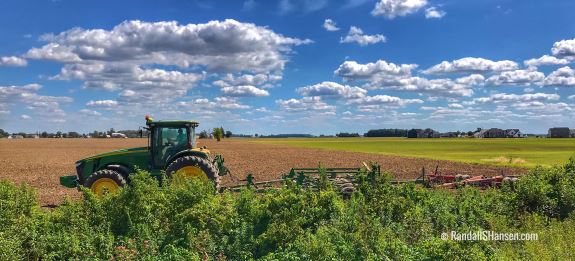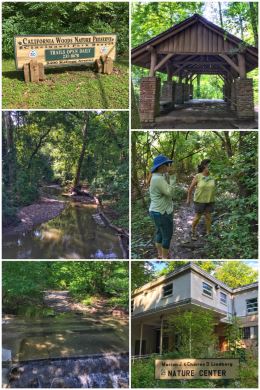
O-H-I-O, the 28th state we have visited on our adventures across the U.S. The state gets its name from the Ohio River (a 981-mile river; the largest tributary to the Mississippi River by volume) whose name originated with an interpretation of the Seneca Indian word ohiːyo’, meaning “great river.” Ohio is the Buckeye State — not for the university but for the Ohio Buckeye Trees.
We focused on three areas of Ohio during our travels: Cincinnati, Toledo, and Akron in an attempt to maximize the nature and minimize actual trips through those cities.
We started in Cincinnati, mainly to see our wonderful friends Gia and Julie… and started our nature fix by visiting Gia at California Woods Nature Preserve. The 113-acre park, part of Cincinnati Parks, has more than 50 species of trees and more than 200 species of herbaceous plants; it is mostly forested, but has about one acre of prairie. Lick Run Creek runs through the preserve, and is home to kingfishers, turtles, and small fish. The park’s Nature Center, originally constructed in 1938, runs programming throughout the year — including summer nature camps for children of all ages. A variety of trails crisscross the property, but we hiked the Ridge Trail.
We have been to some progressive cities that have done some amazing work with green spaces and urban parks — like Tulsa, Oklahoma… and Cincinnati is up there among the best in the nation… the parks system constitutes more than 5,000 acres, which is approximately 10 percent of the city’s total land area. Other interesting parks include Sawyer Point, Eden, Dyer, Jackson Hill, Riverside, International Friendship, Washington, Bettman Preserve, Kennedy Heights, and Bracken Woods.

Cincinnati is located at the northern side of the confluence of the Licking and Ohio Rivers, and Gia led us on a walk along a bit of the Ohio River Trail, ending with a fun crossing of the Purple People Bridge (officially the Newport Southbank Bridge, one of nine bridges that cross the Ohio River in Cincinnati). The pedestrian-only bridge stretches 2,670 feet (one-half of a mile) across the Ohio River, connecting downtown Cincinnati to Newport, Kentucky… and to trails along the river in both states. (We did cross over in Kentucky, but are not counting it as an official stop; visiting Kentucky comes in 2020!)
The bridge, once a railroad bridge owned by the Little Miami Railroad (which had terminal facilities on the Cincinnati side of the river), opened in 1872. In 1897, a 20-foot-wide horse and cart path was added, along with two streetcar tracks. In 1904, the bridge was renamed the L&N (Louisville and Nashville) Railroad Bridge. In 2001, the bridge was placed on the National Register of Historic Places and CSX (the final railroad owner) donated its part of the bridge so that a non-profit (Southbank Partners) now operates and manages the bridge… and, amazingly, they conducted focus groups to determine the best color to paint it — and purple won.
Cincinnati was founded in 1788 — and began its life as three settlements between the Little Miami River and the Great Miami River on the north shore of the Ohio River. It is known as the City of Seven Hills: Mount Adams, Walnut Hills, Mount Auburn, Vine Street Hill, College Hill, Fairmount, and Mount Harrison. It is home to two major sports teams: the Reds (baseball) and Bengals (football). Nine Fortune 500 companies and 15 Fortune 1000 companies have headquarters in the Cincinnati area.
But enough facts about Cincinnati… We parked our trailer in Winton Woods Campground, on the north end of Cincinnati (about 20 minutes north of downtown), a beautiful location in a pine grove alongside Winton Woods Lake… and, most importantly for us, near Gia and Julie’s house. The campground is a great option for folks visiting the area — and had bathrooms, laundry, camp store, full hookups (pull through and back-in), and WiFi.

It was petty darn hot when we were visiting — with temperatures and humidity both in the high 90s — so it was quickly decided that we were going to have another river adventure… this time on the Little Miami River, the state’s first designated State Scenic River, and a tributary of the Ohio River; it flows 111 miles through southwestern Ohio. It is also holds the designation of a National Wild and Scenic River.
Julie and Gia treated us to some wonderful paddling down the river. They brought their kayaks and Jenny and I decided it was time to try canoeing together again. We rented a canoe from Morgan’s Canoe Livery at Ft. Ancient, north of Cincinnati, and headed down the river on a 6-mile journey. (Morgan’s, a family-run business that also has great environmental stewardship, offers 3/6/9-mile river adventures — with pick up locations at each.) Morgan’s also owns the Riverside Campground and Cabins, located about three miles down the river from our starting location — and it’s a great place to stop and stretch your legs (and look for Monarch butterfly eggs as we did that day). The campground is also right along the Little Miami Scenic Bike Trail, a 78-mile rail-trail that runs from just north of Cincinnati up to Springfield (with many miles running right along the river, as well as Caesar Creek Gorge State Preserve). We may have to do parts of the trail the next time we visit Gia and Julie!
We next traveled to the Toledo area, staying at one of our favorite KOA Kampgrounds — and certainly one of our favorite campsites… in the small town of Stony Ridge, just outside of Perrysburg (which has every possible retailer you could want, including another Costco — Store #1194).
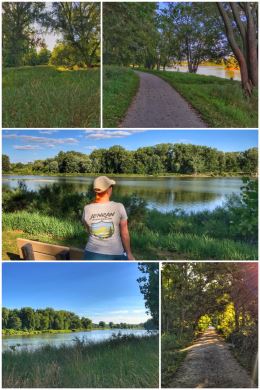
We had thought about going to Toledo — especially for its farmers market — but were told that Toledo Jeep Fest 2019 was taking place that weekend and the city should be avoided at all costs… so instead, we opted for time in nature — and exploring history.
We started at Side Cut Metropark,
a regional park located in Maumee that is part of the Toledo Metroparks system — and was the first Metropark developed. Its name is derived from the former “side cut” extension of the Miami and Erie Canals that connected the main line of the canal with the city of Maumee… but more on that in a moment. We hiked the 1.3-mile Riverview Loop Trail that follows a portion of the Maumee River and can include hiking on a portion of the Towpath Trail (which follows the remains of the Miami and Erie Canal along the old tow path where mules towed flat-bottom boats along the canal) to extend your hike… which is what we did by accident. Several other trails are also located on that side of the park. (Interesting side notes: First, the Maumee River and its watershed are the remains of what was once Glacial Lake Maumee; second, the Maumee River is the largest river on the Great Lakes.)
Crossing over River Road to the west side of the park leads to the .6-mile Canal Locks Trail, where you can see history — the remains of the side cut that lowered canal boats into the Maumee River from the Miami & Erie Canal, which ran from Toledo to Cincinnati. The Miami & Erie Canal, which began construction in 1825, with completion in 1845, created a water route between the Ohio River and Lake Erie — at a cost of about $8 million. At its peak, the canal system included 19 aqueducts, three guard locks, 103 canal locks, multiple feeder canals, and several reservoirs. Ironically, shortly after the canal system was finished, competition from railroads intensified and reduced the need (and commercial use) of the canal. A major flooding of Ohio in 1913 damaged the canal beyond repair and it fell into disuse.
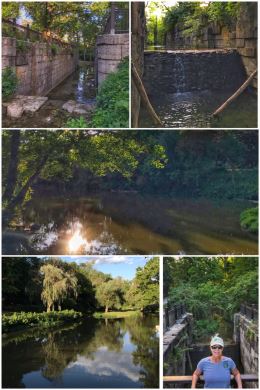
At Side Cut park, along the Canal Locks Trail, one can see the remains of a few of the locks used in the side cut, which was completed in 1842 (and abandoned in 1850). Three of the six original locks from the two-mile long canal system were preserved by Works Progress Administration (WPA) workers during the Depression. The WPA was one of President Franklin Roosevelt’s New Deal programs (along with the Civilian Conservation Corps), employing millions of job-seekers (mostly unskilled men) to work on public works projects around the U.S. The WPA workers also built a number of shelters in the park. This trail — and the amazing remains of the canal locks — is a wonderful piece of history and so evocative as we tried to imagine these boats moving from one lock to the next on their way down to the Maumee River. Canal locks act like elevators — used to raise and lower boats by changing water levels as the boats moved along the canal system.
In total, we hiked about 3.6 miles along the trails in Side Cut Metropark — on a beautiful late afternoon.
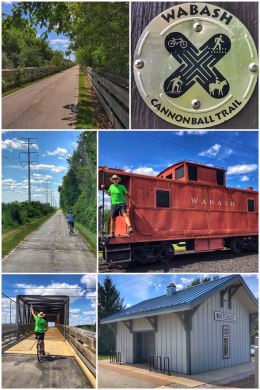
The next day we decided to get our bikes down and ride the Wabash Cannonball Trail, another rail-trail, starting from the parking area of the Fallen Timbers State Memorial.
Fallen Timbers recognizes the
August 1794 battle between U.S. forces and Native Americans — and was key (sadly) in bringing the Indians of the Northwest Territory to sign the Treaty of Greene Ville — in which the Indians ceded southern and eastern Ohio to settlers, which led to Ohio statehood in 1803. The park contains a monument honoring Major General Anthony Wayne (for his decisive victory) as well as smaller monuments to the soldiers and Native Americans who died in the battle. (The battle was fought in an area that had been recently hit by a severe windstorm that knocked down a large number of trees… thus the name.) Interesting side note: Major General (Mad Anthony) Wayne died just two years after the battle in 1796 while on active duty. Various places and things have been named after him, including the cities of Fort Wayne, Waynesburg, and two Waynesboros. Wayne State University is also named after him.
The Wabash Cannonball is northwest Ohio’s longest rail-trail conversion at 63 miles — and is part of the regional bikeway system. Its 12-foot wide trail surface varies from asphalt to hard-packed cinder ballast — and is still under development in some sections. The trail follows the former rail corridor of Norfolk Southern Railroad first established by the Wabash Railroad — and consists of two rail lines that converge in Maumee at Jerome Road. The “North Fork” of the Trail runs in an east-west direction, going 46 miles from Maumee to within 15 miles of the Indiana state line near Montpelier, Ohio. The “South Fork” takes a southwesterly route from Maumee to the edge of Liberty Center, Ohio, for a length of 17 miles. Parts of the trail are also segments of the North Country National Scenic Trail, a 4,600 mile long hiking trail we have mentioned in previous blog posts.
We biked from the Fallen Timbers State Memorial to Whitehouse along the Southern Fork — for a roundtrip of about 15.5 miles. Whitehouse is a great place to stop, as Whitehouse Park has restrooms and picnic tables. An added bonus? Right along the trail is a red caboose, circa 1927.

We ended our visit to the area with a visit to another Metropark: Oak Openings Preserve, the largest of the Toledo Metroparks with about 5,000 acres. Located between Whitehouse and Swanton, about 25 miles southwest of Toledo — Oak Openings Preserve takes its name from the surrounding region of oak savanna (characterized by alternating wetlands and vegetated dunes), which is 23 times larger than the park itself (and actually extends into parts of Michigan). The Nature Conservancy once named this sandy region one of the 200 “Last Great Places on Earth.” Oddly, the park also includes stands of pine and spruce (mistakenly?) planted by the WPA during the Great Depression. (Some of these trees are now being removed as they are not part of the oak savanna ecosystem.)
There are plenty of trails in the park for hiking, biking, and horseback-riding. In fact, the paved Cannonball Wabash Rail-Trail runs east-west almost directly in the middle of the park; there is also a 5.3-mile (RT) paved bike trail in the park. We focused our time on two interconnecting trails that can be easily accessed from the parking area at the Buehner Center at the southern end of the park. From there, we hiked the 1.5-mile Foxfire Trail and the 3.2-mile Ridge Trail — both loops. The trails also intersect (and sometimes run parallel) to some horse trails and we ran into several women enjoying the day riding their horses.

Other hiking trails at the park include the Sand Dunes Trail (2-mile RT), Ferns & Lakes Trail (2.7-mile RT), Evergreen Trail (2.2-miles RT), as well as the longer Oak Openings Hiking Trail (15.3-miles RT).
Finally, the park even has several mountain-biking trails, as well as a cross-country ski trail maintained in the winter. The park also contains a lodge, two campgrounds, picnic facilities, and a horse center. The Buehner Center, as well as the Pine Ridge Chalet can be reserved. The park also includes to wedding sites that can be reserved. Fishing is also permitted at Evergreen and Mallard lakes.
More than 1,000 different plant species have been documented growing in the oak savanna, and the park protects a number of plants considered endangered or threatened by state or federal governments. We loved seeing the flowers of the prairie along the trails in the park.
We ended our trek across Ohio with a stop just outside of Akron — with our main goal of visiting the Cuyahoga Valley National Park — which we cover in our next blog post (Stop 100). But that does not mean we just visited the national park.
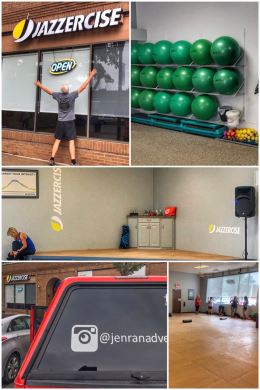
In fact, we hit a patch of rainy weather, which made it a perfect day to get work done (grading for Ran and internship resourcing for Jen)… and hit up another Jazzercise!
We attended a fun and energetic Dance Mixx at the Jazzercise Wadsworth Fitness Center, which is a neat center offering a variety of classes. Everyone was very friendly — and hopefully we inspired some folks to find ways to get out in nature… even if just one day at a time.
The Jazzercise Wadsworth Center is one of more than 8,300 franchise locations around the world. Judi Sheppard Missett founded the dance fitness franchise company in 1969 — and this year celebrated 50 years of operations. The exercise routines in Jazzercise provide a full-body workout — combining dance, strength, and resistance training with a mix of fun music. Jenny and I always leave with sweat on our brows and smiles on our faces.
But back to our campground. One thing we have discovered on this trip is that every campground website is organized differently, though many do list an “amenities” page — which typically includes bath/shower house, playground, pool, Wifi, cable television, etc. Sadly, most do not provide much details. For example, Countryside Campground lists “free WiFi” but neglects to say that it is only available at the office; campers have to pay for WiFi if they want it at their site. (Annoyingly, the paid WiFi was pretty crappy at our site too.) Why can’t campgrounds just provide all the details and let the campers decide?
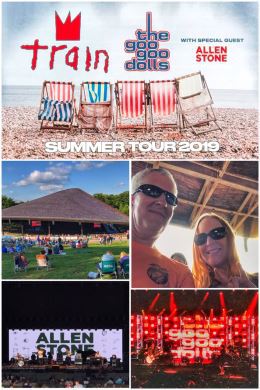
One of the other pages that many campgrounds publish on their websites list the local attractions… and we discovered that another summer/outside music amphitheater was located just 10 miles north of Akron (and about 29 miles south of Cleveland). The Blossom Music Center, located in Cuyahoga Falls (an Ohio community first settled in the early 1800s), is situated on 800 acres of rolling hills surrounded by the Cuyahoga Valley National Park. The music center is the summer home of the Cleveland Orchestra, which performs its annual Blossom Festival there.
Luckily for us, we discovered that the final night we were going to be in the Akron area, a concert was scheduled at the Blossom — with a lineup we could not resist: Opening with Allen Stone, followed by the Goo Goo Dolls, and concluding with Train. So after a dry spell of not seeing much live music while on the road, we have now taken in two big summer concerts!
Allen Stone was a great opening act — and how cool that he was born and raised in Chewelah, Washington, a small town in northeast Washington! He started his music career — a mix of soul and rhythm and blues — in the Seattle area… and self-releasing his first album before his music career began to take off.
The Goo Goo Dolls — which formed in 1986 in Buffalo, New York (only about 180 miles from Cleveland) — include guitarist/vocalist Johnny Rzeznik and bassist/vocalist Robby Takac. They have had 19 top ten singles on various charts, and have sold more than 12 million albums worldwide. They sang a number of their top songs, including Iris, Name, Black Balloon, and Slide… and were energetic and in top form.

While Allen Stone and the Goo Goo Dolls were fun, the show ended with a great set from Train, with leader singer Patrick Monahan spreading love and positivity!
Of course, it helped that this concert was one of the last of the current tour and also a homecoming of sorts… the band formed in San Francisco in 1993, but Monahan announced he grew up in (our next stop) Erie, PA — about 120 miles northeast from the Blossom — so both Monahan and Rzeznik and Takac felt they were close to home. In fact, Monahan told the crowd that he attended concerts at the Blossom, including one that changed his life — a Steely Dan concert. In honor of that concert, the band payed a great rendition of Reelin’ in the Years.
Train also played a number of their most popular songs, including Calling All Angels; Hey Soul Sister; Drops of Jupiter; Marry Me; Save Me, San Francisco; and Meet Virginia. They also played Led Zeppelin’s Heartbreaker, in which they did an amazing job — but not surprising since just two years ago Train released the album Train Does Led Zeppelin II, which was a song
song by song replication of Zeppelin’s classic 1969 album (which includes Heartbreaker).
We feel extremely fortunate to have now attended two wonderful summer concerts. The Heart concert in Indiana was a great experience, but this concert was so upbeat, energetic, and powerful — in the ways you want live music to be.
What a crazy day that was — from the national park all day and then the concert that evening. The only slight downer was the long wait to get out of the parking lot; Blossom Music Center needs to work on a better system as it should not take about 40 minutes just to exit the property.
Next up? We head into Pennsylvania, our 29th state on this adventure!
